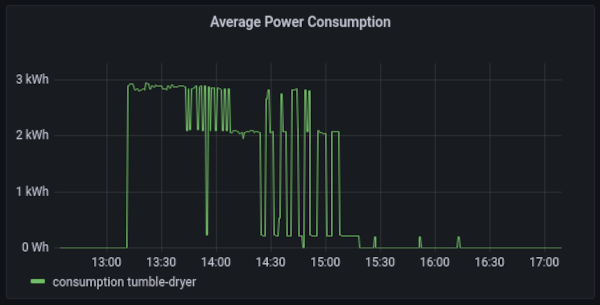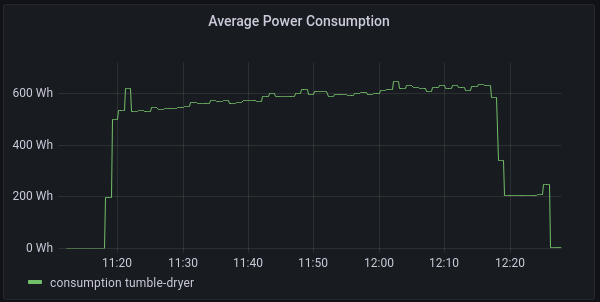Comparing the Power Consumption of Heat Pump and Condensing Tumble Dryers
For reasons, we've ended up getting a new tumble dryer. Given the cost of energy, I wanted the new dryer to be heat pump based so that it'd cost less to run.
Through a combination of lucky timing (online discounts combined with credit card cashback deals) and general good luck, we managed to snaffle one for a good chunk less than the usual price (even if it did arrive days late).
I've long collected energy consumption readings from our larger appliances, so I wanted to use them to see what the practical difference in consumption actually is.
This post compares the energy consumption of a Beko Condensing Tumble Dryer to a Bosch Series 4 Heat Pump Dryer
Stats collection
I've written in the past about how I track our energy usage, so I'll simply summarise here
- Large appliances are plugged into Tapo smart sockets
- I poll them for stats using a docker container
- Stats are then written into InfluxDB
- I have an energy consumption Grafana dashboard, querying stats out using Flux
Manufacturer Specifications
Whilst looking at options, I compared the manufacturer specifications between the existing Beko dryer and the models that I was considering.
The Bosch spec claims the following usage

Whilst the Beko spec claims

A footnote shows that this is based upon the same measure as the Bosch
Energy consumption based on 160 drying cycles of the standard cotton programme at full and partial load, and the consumption of the low-power modes. Actual energy consumption per cycle will depend on how the appliance is used
We can work out the average per-run energy cost for each by dividing their annual consumption by the number of cycles (160):
- Bosch:
1.1 kWh/run (£0.39 a run at 35p/kWh) - Beko:
3.15 kWh/run (£1.10 a run at 35p/kWh)
On average, then, we should expect the Bosch to use about 35% of the energy
Beko Power Consumption
I took readings from the Beko's final cycle

Nothing too surprising there really, there's an initial and prolonged blast of heat before the thermostat kicks in and the dryer starts turning the element on and off.
After the heating ends, there's only the energy consumption of the drum motor - switching on and off periodically as the anti-crease mechanism keeps things from settling for too long.
Energy consumption in that period (with energy prices at the Government's cap of £0.35/kWh) was

Bosch Power Consumption
I checked a few runs in the Bosch and have used the most expensive here: drying a full load of heavy cotton towels.

The thing that immediately stands out here is just how much lower the peak draw is. Even the final spike in usage is only about 25% of the Beko's peak draw.
It is, however, also a much more sustained load: we don't see the peaks and troughs that the Beko had.
Energy consumption in that period was

The cost calculation is a little off (the end of the cycle overlapped a time window so the unit price didn't combine in properly, I'll have to fix that query). The actual consumption cost was £0.59.
Comparison
We can pull a few comparative points from this
- Cycles take longer in a heat-pump dryer (although the towel cycle is something of an extreme example).
- The Bosch consumed just
41%of the energy used by the Beko - The per-cycle run in the Bosch is
41%of the Beko
Break Even
The observed per-cycle energy cost difference between the two machines was £0.90. However, when bought at full price (around £600), the Bosch Series 4 is not a cheap appliance.
Assuming that the savings average around the 90 pence mark, break even sits at 666 cycles (a little under 2 years at 1 cycle a day). That, of course, assumes that energy prices don't rise further (and it's expected that they will).
Break even within a couple of years isn't too bad, but is only achievable if you're currently drying laundry daily. If instead you're doing it weekly the break-even is 12 years away.
In practice, calculating breakeven is quite complex, because there are various confounding factors. For example, if you're only drying washing weekly, is that because that's all that's needed, or because the cost of doing it more frequently has been cost prohibitive? If so, break even probably isn't actually 12 years away because you derive additional, but hard to quantify, benefit.
For some households, there's an additional factor: solar.
Solar can really complicate calculations, because both of the following are true
- Solar lowers cost per kWh, in turn reducing the per-cycle savings lower resulting in an extended breakeven period
- A lower consumption appliance increases the likelihood of being able to run entirely from solar + battery, reducing the amount of (more expensive) energy pulled from the grid
The second point is pretty important, because the peak draw of a heat-pump dryer is significantly lower than that of a condensing dryer. This increases the likelihood of Solar (and battery and inverter) having sufficient capacity to fully drive the dryer, rather than having to make up the difference by pulling from the grid.
Conclusion
Obviously, there are a few issues with scientific rigour here: the two dryers were not drying comparative loads (that'd be fairly hard to get exactly right in a household setting), which has almost certainly introduced some bias against the heat-pump dryer (which definitely had the harder load: sopping wet towels).
Despite that, the observed energy usage isn't all that far off the proportions suggested by the manufacturer's specifications. Both machines used slightly more than the average calculated from the spec, but that's just the nature of averages.
So the question is, is a heat pump dryer worth buying?
They've got a high capital cost (you can find cheaper than the Bosch, but they're still expensive compared to a condensing dryer), so the break-even point can be quite a long way out.
There are, though, other savings that are harder to quantify.
The heat-pump dryer doesn't blow out hot moist air in the way that a condenser does. With a condensing dryer, you need to ensure there's good ventilation (normally a door or window open), otherwise you can end up with condensation, causing damp, mould and health issues.
We've found that unless the load is particularly wet (like the towels) we don't generally need to leave a window open for the heat-pump dryer. Not having that window open means that the heating doesn't need to make up for heat lost out of it (or by it creating draughts).
The lower energy consumption also means that each cycle has a lower environmental cost.
Overall, it definitely seems worth spending the extra up front, if only because the lower energy costs mean that you're more likely to be comfortable using it when you most need it (are you really achieving better value if you buy a cheaper machine that you then daren't use because of energy costs?)
Update 30 Dec 22
Today, I've tallied up the appliance's power consumption since this article was written and then divided by the number of cycles in order to get the average per-cycle consumption and cost
- Consumption: 1.1 kWh
- Cost: £0.385
That figure includes use of a range of the machine's pre-sets.
The "40 minute" cycle is quite surprising. Just like with Bosch washing machines, the name is a lie. The timer displays 45 minutes, and the machine draws power for 50 minutes.
However, I had assumed that the short mode would be something of a power drain (more energy == more heat == faster drying), but that's not actually the case

In total, the cycle consumed 1.32 kWh.
There's also a "Down Wear" mode (the "Wear" is misleading - the manual says it means down filled items: pillows, duvets etc). Drying a freshly washed single duvet consumed 0.785 kWh.

